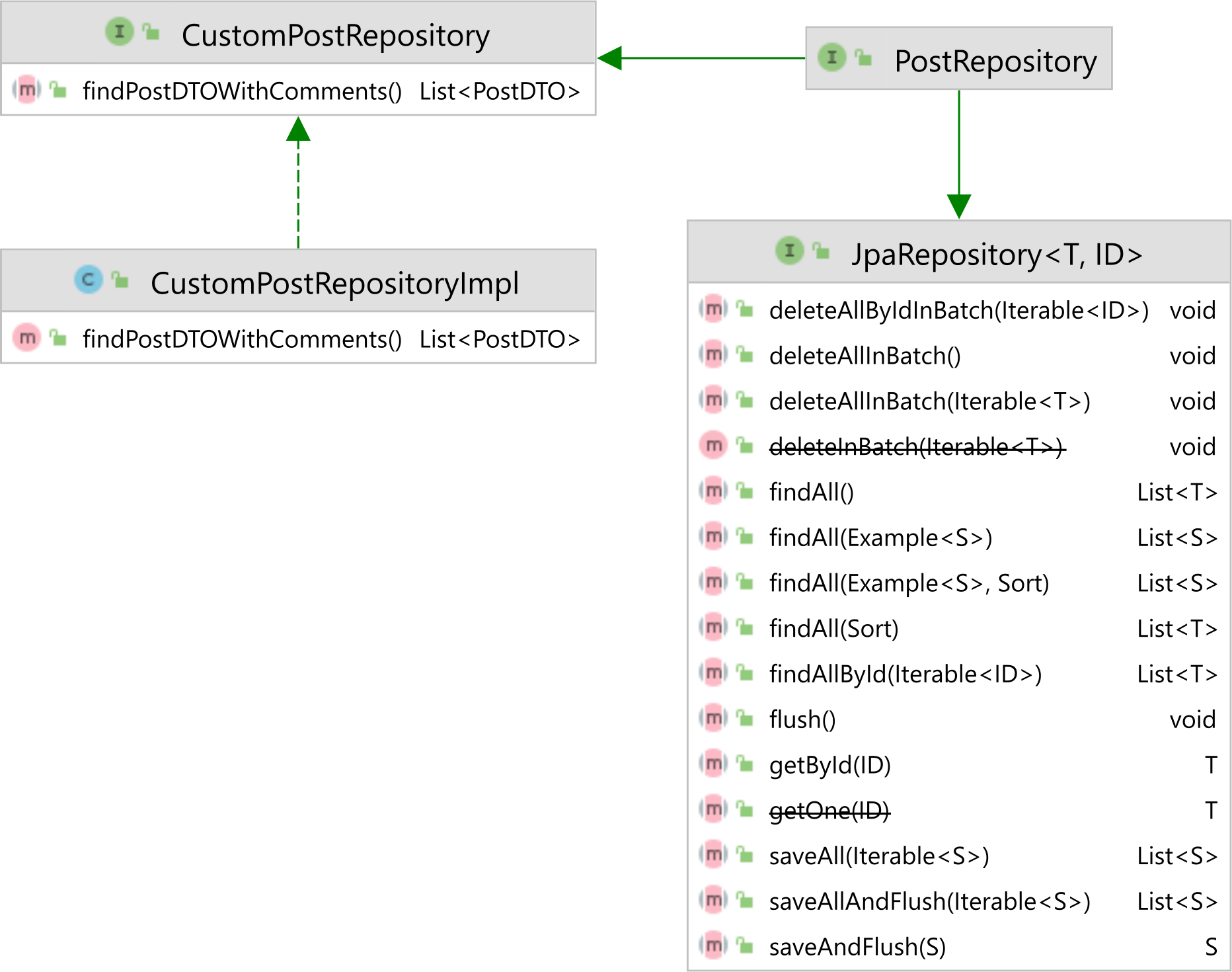

The best way to write a custom Spring Data Repository
source link: https://vladmihalcea.com/custom-spring-data-repository/
Go to the source link to view the article. You can view the picture content, updated content and better typesetting reading experience. If the link is broken, please click the button below to view the snapshot at that time.
If you are trading Stocks and Crypto using Revolut, then you are going to love RevoGain!
Introduction
In this article, I’m going to show you the best way to write a custom Spring Data Repository.
While the default JpaRepository methods, as well as the query methods, are very convenient in many situations, there might be times when you need custom Repository methods that can take advantage of any JPA provider-specific functionality.
When to use a custom Spring Data Repository
Let’s assume we want to fetch a one-to-many DTO projection, as I explained in this article.
Our JPA query looks like this:
List<PostDTO> postDTOs = entityManager.createQuery("""select p.id as p_id,p.title as p_title,pc.id as pc_id,pc.review as pc_reviewfrom PostComment pcjoin pc.post porder by pc.id""").unwrap(org.hibernate.query.Query.class).setResultTransformer(new PostDTOResultTransformer()).getResultList();Notice that we are unwrapping the JPA Query to a Hibernate org.hibernate.query.Query in order to provide a custom ResultTransformer that can build a hierarchical parent-child DTO aggregate from the default table-based Object[] projection.
We can’t just use a regular Spring Data Repository query method or a @Query annotation because we also have to pass our own Hibernate-specific ResultTransformer.
Therefore, we need to write a custom Repository that can provide us access to the underlying JPA EntityManager so that we can write our query using the Hibernate-specific API.
How to write a custom Spring Data Repository
First, we need to define an interface that provides the method signatures of our custom Repository methods.
public interface CustomPostRepository {List<PostDTO> findPostDTOWithComments();}Second, we need to provide an implementation of the CustomPostRepository interface:
public class CustomPostRepositoryImpl implements CustomPostRepository {@PersistenceContextprivate EntityManager entityManager;@Overridepublic List<PostDTO> findPostDTOWithComments() {return entityManager.createNativeQuery("""SELECT p.id AS p_id, p.title AS p_title,pc.id AS pc_id, pc.review AS pc_reviewFROM post pJOIN post_comment pc ON p.id = pc.post_idORDER BY pc.id""").unwrap(org.hibernate.query.Query.class).setResultTransformer(new PostDTOResultTransformer()).getResultList();}}Third, we need to make the default Spring Data JPA PostRepository extend our CustomPostRepository interface:
@Repositorypublic interface PostRepository extends JpaRepository<Post, Long>, CustomPostRepository {}A picture is worth 100 words, so here’s a diagram that shows you how the custom Spring Data Repository is associated to the standard JpaRepository one:

Testing time
Assuming we have two Post entities, the first one having two PostComment child entities, and the second Post having a single PostComment child:
entityManager.persist(new Post().setId(1L).setTitle("High-Performance Java Persistence").addComment(new PostComment().setId(1L).setReview("Best book on JPA and Hibernate!")).addComment(new PostComment().setId(2L).setReview("A must-read for every Java developer!")));entityManager.persist(new Post().setId(2L).setTitle("Hypersistence Optimizer").addComment(new PostComment().setId(3L).setReview("It's like pair programming with Vlad!")));When calling the findPostDTOWithComments method, we are going to get the expected PostDTO hierarchical projection:
List<PostDTO> postDTOs = forumService.findPostDTOWithComments();assertEquals(2, postDTOs.size());assertEquals(2, postDTOs.get(0).getComments().size());assertEquals(1, postDTOs.get(1).getComments().size());PostDTO post1DTO = postDTOs.get(0);assertEquals(1L, post1DTO.getId().longValue());assertEquals(2, post1DTO.getComments().size());assertEquals(1L, post1DTO.getComments().get(0).getId().longValue());assertEquals(2L, post1DTO.getComments().get(1).getId().longValue());PostDTO post2DTO = postDTOs.get(1);assertEquals(2L, post2DTO.getId().longValue());assertEquals(1, post2DTO.getComments().size());assertEquals(3L, post2DTO.getComments().get(0).getId().longValue());Cool, right?
If you enjoyed this article, I bet you are going to love my Book and Video Courses as well.
Conclusion
While it’s very common to see standard Spring Data repositories that extend the JpaRepository interface, a custom Repository can allow you to take advantage of all the features provided by JPA or the underlying JPA provider.
Recommend
About Joyk
Aggregate valuable and interesting links.
Joyk means Joy of geeK